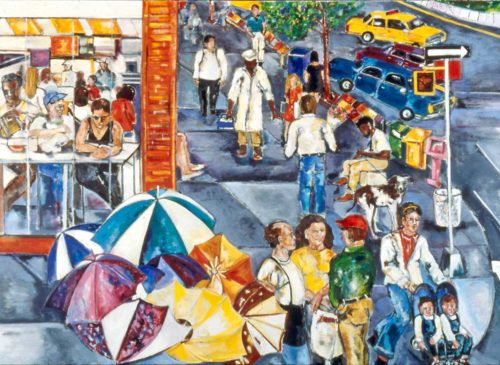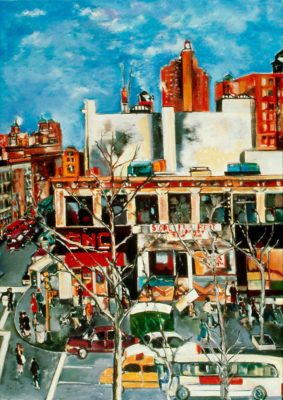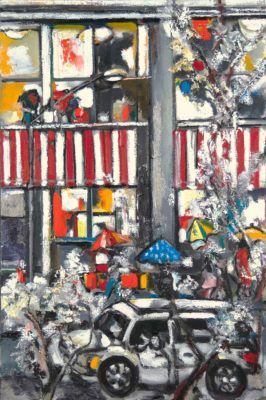Mari Lyons Memorial Exhibition: The Vital Street
Review by John Goodrich, guest contributor
January 30 – February 24, 2018 at First Street Gallery, NYC
Over the long course of her life as a painter, Mari Lyons (1935-2016) explored a wide range of genres, from portraits to still lifes, interiors and landscapes. All these subjects she rendered with a modernist’s flair for heightened color, vigorous brushwork, and simplified, often flattened spaces. The memorial exhibition at First Street Gallery presents what may be the single most appealing and accessible of her motifs: the cityscapes she painted from the window of studio at West 80th Street and Broadway.
Among her many teachers, Max Beckmann may have made a particular impression of the artist; one can imagine his influence in Lyons’ bold, dark outlines and sometimes distended forms. But these thirty paintings and works on paper vividly catch the staccato rhythms of Lyons’ own subject, observed for some forty years from her third-floor vantage point. Taxis and crosswalks tilt at crazy angles, signs cry out brand names, and pedestrians weave through the clatter, and yet Lyons manages to keep everything under control, so that one never loses the sensation of looking down upon a unified, spreading scene. The artist’s pleasure in the sheer spectacle of the street is immediately apparent, but so is her savviness about constructing a painting.
Indeed, Lyons seems to invite every visual complication. In one canvas, trees dotted with clumps of snow set off the regular beat of a red and whited striped awning. In others, she records the utter transformations of roads and sidewalks by rainfall, which turns concrete into a patchwork of damp, dark spots and brightly reflecting puddles – the whole punctuated by the colorful crescents of umbrellas. Many a modern cityscapist avoids cars because of their usual lack of charm and complex, shiny surfaces. But Lyons clearly delights in the here and now – however it presents itself – and she pursues this particular challenge, too, often distorting the vehicles’ proportions and angles. (They still convince, rhythmically; the artist wisely prioritizes pictorial heft over perspectival accuracy.)
In their battle between busyness and cohesion, the former wins in a few of the paintings. But others evoke an impression of cohering abundance – a distant echo of Brueghel’s teeming orderliness, in which every element, large and small, plays its part. In these, a central hierarchy of forms unfolds, in the horizontal tiers of facades/ street/sidewalk, or the uncoiling arc of a wall in Broadway’s center divider. Further looking reveals worlds within these worlds – communities of interacting figures within a bus shelter, or a shop window.

Mari Lyons, Thursday Afternoon on the Corner of West 80th Street and Broadway, 2001, oil on linen, 48 x 72 inches. Courtesy of Nick Lyons
While the installation – especially in the gallery’s smaller space – feels slightly crowded, the strategic hanging of the strongest paintings shows them to good advantage. Among these is “Thursday Afternoon on the Corner of West 80th Street and Broadway,” which from twenty feet away greets the arriving visitor. Focusing on a single street corner, this six-foot-wide canvas could be a blown-up portion of the more panoramic views hanging on every other wall. With its much closer vantage point, the viewer practically stands among the pedestrians. The familiar “stacked” space develops as overlapping color-forms that generously pace the movement, figure by figure, into the depths. Lyons seizes the opportunity to explore eccentric details: a pile of opened umbrellas, spreading like a huge, tropical bouquet; an autonomous pair of legs, apparently belonging to a person seated around a building’s corner; twin toddlers in a double stroller, the stroller hoods surrounding them like Egyptian cartouches. The painting celebrates two life forces: the ever-changing energy of New York City, and the peculiar powers of paint to re-make it.







Leave a Reply